Abstract
As physical capabilities decline with age, elderly individuals often require assistance from others when using the toilet. An auxiliary standing toilet chair can enhance convenience for the elderly, allowing them to use the toilet independently. Commercially available auxiliary standing toilet chairs and related patents share common issues, such as seat link rotation angles of less than 45° and a high driving force requirement. This study categorizes four-bar linkages into three design concepts and then carries out a kinematic design process based on the design requirements and constraints of the auxiliary standing toilet chair. Three feasible design examples were developed, followed by motion simulations and driving force analyses using INSPIRE 2019.2 software. In Design Example I, an actuator directly drives the seat link, rotating the seat to 48°. The required driving force for a 150 kg user is reduced from 6070 N to 2258 N, representing a 62.35% reduction in the required force.
1. Introduction
Due to declining physical abilities, many elderly people face difficulties in their daily lives. For example, using the toilet is an essential yet inconvenient and private activity for which assistance from others may be undesirable. Although new generations of auxiliary standing toilet chairs have been developed to accommodate various user needs, most commercial products and patents exhibit issues such as a limited seat rotation angle and excessive seat lift. Moreover, ensuring a safe transition from sitting to standing is paramount. To address these issues, this study examines the kinematics of leg movement during sit-to-stand transitions and analyzes existing products and patents [1,2,3,4,5,6].
The main findings of the research include the following:
- Existing products and patents typically feature seat links with limited rotation around the knee joint, generally ranging from 16° to 30°, which falls short of the required 45° gravity transfer angle.
- The rotation angle of the seat must be increased while ensuring the seat height aligns with the standing position to eliminate tiptoeing hazards.
- The actuator force required for a 150 kg user to stand in commercially available products ranges from 1700 to 6070 N.
- Most auxiliary standing toilet chair mechanisms incorporate four-bar linkage mechanisms.
The innovative methodologies adopted in this study include Osborn’s [7] SCAMPER checklist method, Yan’s [8] creative mechanical device design approach, and specialized methods for assistive device development by Hsu and Hsieh et al. [9,10,11] that simultaneously consider mechanical functionality and user experience. Based on four-bar linkage mechanisms and using the morphological analysis method [8] to position fixed pivots, this study proposes three design concepts, resulting in four design cases for auxiliary standing toilet chairs. These designs feature seat rotation angles exceeding 45° and require a maximum driving force of less than 3000 N. By synthesizing findings from the kinematic mechanism analyses [12,13,14,15,16], the proposed design examples aim to address existing shortcomings and provide elderly individuals with safer and more comfortable toileting solutions. For Design Cases I-III, the maximum seat rotation angles exceed 45°, meeting the design requirements, and the driving force remains below 3000 N.
2. Sit-to-Stand
Based on the research conducted by Hirschfeld et al. [1] and Sato et al. [2], the sit-to-stand motion can be divided into four distinct phases: the “Leaning Period”, “Transfer Period”, “Upright Period”, and “Stability Period”, as depicted in Figure 1a. Furthermore, researchers have defined the hip joint angle (θH), knee joint angle (θK), and ankle joint angle (θA), as shown in Figure 1b. The angular displacements of the hip joint (θH), knee joint (θK), and ankle joint (θA) throughout the sit-to-stand process are illustrated in Figure 1c.

Figure 1.
The four stages of the sit-to-stand movement and the definition and angular displacement of joints [1,2].
The design of the auxiliary standing toilet chair is not influenced by the angular displacement of the hip joint (θH) but must accommodate the angular displacements of the knee joint (θK) and ankle joint (θA). According to Figure 1b,c, when the toilet chair moves to assist individuals in standing, the ankle joint angle (θA) initially increases slightly before decreasing (as the lower leg rotates forward and then backward). During the standing movement, the knee joint angle (θK) initially decreases gradually before declining rapidly.
3. Existing Mechanism
3.1. Toilet Aid for Older People [3]
Figure 2 and Figure 3 illustrate an existing toilet aid for older people and its corresponding skeleton mechanism, respectively [3]. The mechanism of the toilet chair comprises four links (N) and four joints (J). The actuator directly drives seat link 3 to move upward and rotate. After integration with the actuator, it becomes a six-link, seven-joint mechanism (N = 6, J = 7), featuring six revolute pairs and one sliding pair (J = 7). Based on the degrees of freedom formula, the mechanism has one degree of freedom, as shown in Equation (1). However, for an auxiliary standing toilet chair to effectively facilitate the sit-to-stand movement, the instantaneous center I13 must be positioned close to the knee joint. Figure 3 illustrates that the instantaneous center I13 in this design is distant from the knee joint, making it unsuitable for the sit-to-stand motion. An analysis using the computer-aided engineering software INSPIRE 2019.2 shows that the rotation angle of the seat link (3) is only 16°. For a person weighing 150 kg (equivalent to 1500 N), the required driving force is 1839 N, as shown in Figure 4. This design has the following disadvantages:
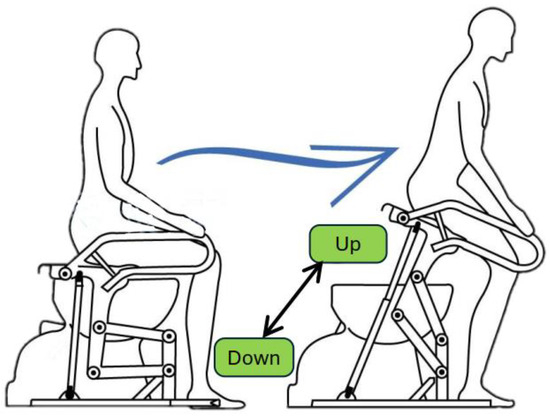
Figure 2.
Toilet aid for older people [3].
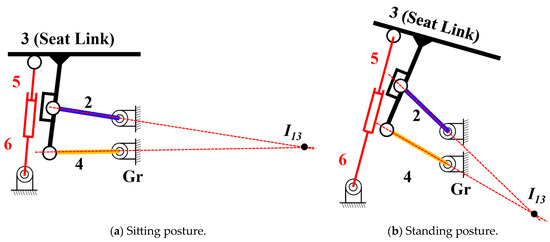
Figure 3.
The skeleton of toilet aid for older people [3].
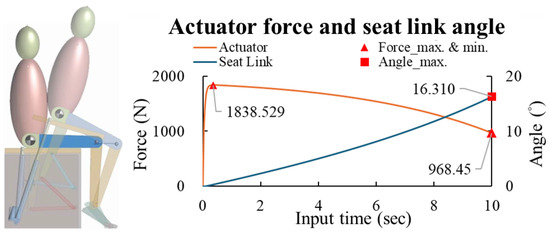
Figure 4.
The seat link rotation angle and actuator force of the toilet aid for older people [3].
- The overall height is too high, and the feet cannot be completely placed on the ground.
- The stroke of the actuator is too large (250 mm).
- The rotation angle of the seat link is only 16°, which does not meet the movement requirements of the human body during the transition from sitting to standing.
3.2. Lifting Mechanism for Toilets [4]
Figure 5 illustrates the lifting mechanism for toilets and its corresponding skeleton mechanism [4]. This toilet chair mechanism consists of four links and four joints. The actuator drives the joint between link (2) and link (3) to move upward and rotate. After integration with the actuator, it becomes a six-link, seven-joint mechanism (N = 6, J = 7), featuring six revolute pairs and one sliding pair (J = 7). Based on the degrees of freedom formula, the mechanism has one degree of freedom, as shown in Equation (2). However, as illustrated in Figure 5c, the instantaneous center I13 of this design is distant from the knee joint, making it unsuitable for the sit-to-stand movement. An analysis using the computer-aided engineering software INSPIRE shows that the rotation angle of the seat link (3) is only 30.22°. For a person weighing 150 kg (equivalent to 1500 N), the required actuator force is 4443 N, as shown in Figure 6. This design has the following disadvantages:
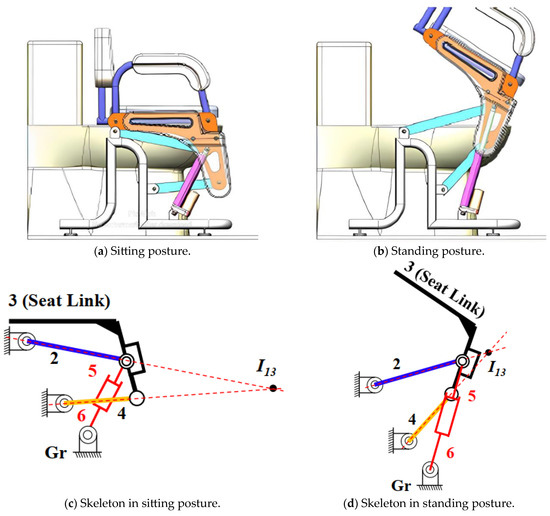
Figure 5.
The lifting mechanism for the toilet and its skeleton [4].
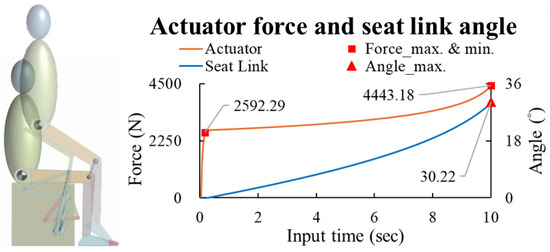
Figure 6.
The seat link rotation angle and actuator force of the lifting mechanism for the toilet [4].
- The seat link is raised too high, and users must stand on their tiptoes, which increases the risk of injury.
- The rotation angle of the seat link is only 30.22°, which does not meet the movement requirements of the human body during the transition from sitting to standing.
- The positioning of the actuator is suboptimal, requiring a high actuator force of 4443 N.
3.3. Apparatus for Lifting Movable Base of Toilet [5]
Figure 7 illustrates the apparatus for lifting the movable base of toilet and its corresponding skeleton mechanism [5]. This toilet chair mechanism comprises four links and four joints. The actuator drives the joint between link (3) and link (5) to move upward and rotate. After combining it with the actuator, it becomes a six-link, seven-joint mechanism (N = 6, J = 7), featuring six revolute pairs and one sliding pair (J = 7). Based on the degrees of freedom formula, the mechanism has one degree of freedom, as shown in Equation (3). As shown in Figure 7c, the instantaneous center I13 of this design is positioned far from the knee joint, making it inadequate for supporting the sit-to-stand movement. According to an analysis conducted using computer-aided engineering software INSPIRE, the rotation angle of the seat link (3) is only 30.16°. For a person weighing 150 kg (equivalent to 1500 N), the required actuator force is 6070 N, as shown in Figure 8. This design has the following disadvantages:
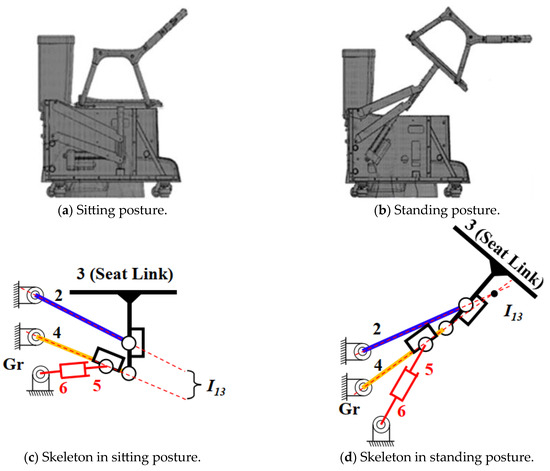
Figure 7.
The apparatus for lifting the movable base of a toilet and its skeleton [5].

Figure 8.
The seat link rotation angle and actuator force of the apparatus for lifting the movable base of the toilet [5].
- The seat link is positioned too high, requiring users to stand on their tiptoes, which increases the risk of injury.
- The seat link’s rotation angle is only 30.16°, which fails to accommodate the natural sit-to-stand movement.
- The actuator’s placement is suboptimal, resulting in an excessively high actuator force requirement (6070 N).
3.4. Heavy Duty Power-Assisted Toilet Seat Lift Assembly [6]
Figure 9 shows a heavy-duty power-assisted toilet seat lift assembly and its corresponding skeleton mechanism [6]. This toilet chair mechanism consists of six links and seven joints. The actuator directly drives the seat link (3) to move upward and rotate. After combining with the actuator, it becomes an eight-link and ten-joint mechanism (N = 8, J = 10), featuring nine revolute pairs and one sliding pair (J = 10). Based on the degrees of freedom formula, the mechanism has one degree of freedom, as shown in Equation (4). Figure 9 shows the instantaneous center positions for sitting and standing, indicating minimal variation in the distance between the knee joint and the instantaneous center in both positions. Therefore, it satisfies the kinematic requirements for the sit-to-stand movement. According to the analysis by the computer-aided engineering software INSPIRE, the rotation angle of the seat link (3) is only 26.38°. For a person weighing 150 kg (equivalent to 1500 N), the required actuator force is 1700 N, as shown in Figure 10. This design also has the following disadvantages:
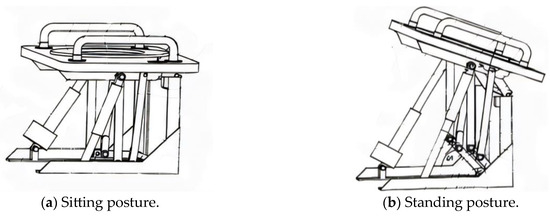
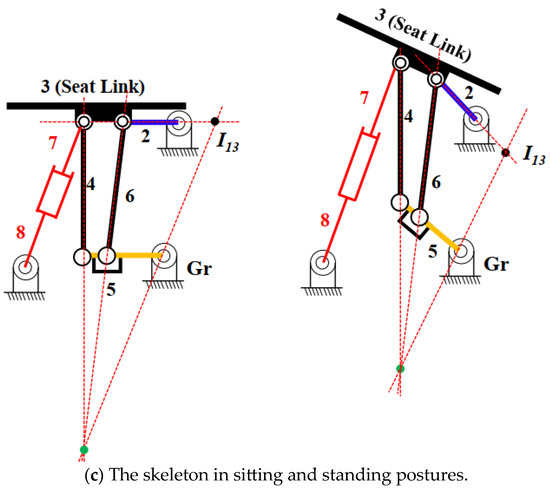
Figure 9.
The heavy-duty power-assisted toilet seat lift assembly and its skeleton [6].
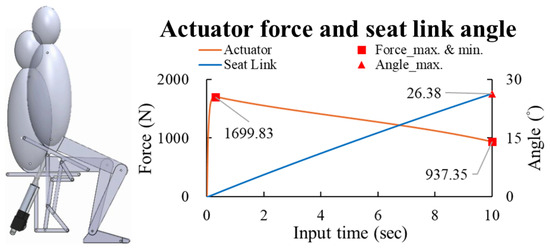
Figure 10.
The seat link rotation angle and actuator force of a heavy-duty power-assisted toilet seat lift assembly [6].
- The excessive forward movement in the seat link causes significant forward bending of the calf, which may increase the risk of injury.
- The rotation angle of the seat link is only 26.38°, which fails to meet the movement requirements for transitioning from sitting to standing.
4. Mechanism Design
4.1. Design Concepts
Based on the analysis of existing products and patents related to auxiliary standing toilet chairs, most mechanisms, excluding those utilizing a power cylinder, are based on four-bar linkages. This paper focuses on four-bar linkage-based designs, which can be categorized into three concepts based on the position of the fixed pivots. In Design Concept I (Figure 11a), the pivots are positioned at the rear of the chair. In Design Concept II (Figure 11b), the two fixed pivots are located at the front of the chair. In Design Concept III (Figure 11c), the two fixed pivots are positioned on opposite sides, with one positioned at the rear and the other at the front. The mechanism in Figure 2 belongs to Design Concept II, while the mechanisms in Figure 5 and Figure 7 belong to Design Concept I.
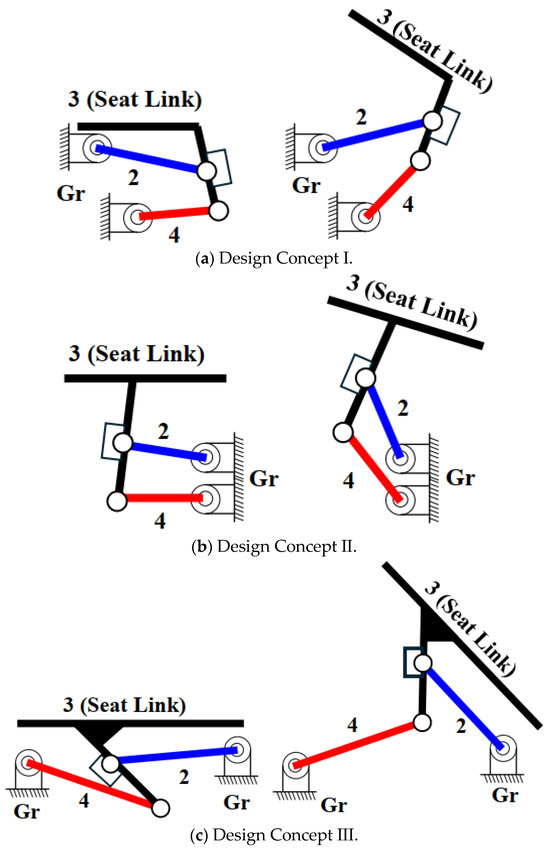
Figure 11.
Three design concepts for the mechanism of an auxiliary standing toilet chair.
4.2. Design Requirements and Constraints
Based on human kinematics, the design requirements and constraints for the auxiliary standing toilet chair are outlined as follows:
- The seat link must be a coupler link and not be adjacent to the ground link.
- The angular displacement of the seat link (from sitting to standing) should exceed 45°.
- Tiptoeing must be avoided. During operation, the front edge of the seat should move both forward and upward.
- The dimensions of the auxiliary standing toilet chair must be within a depth of 400 mm–440 mm, a width of 370 mm–400 mm, and a height of 400 mm–430 mm, as shown in Figure 12.
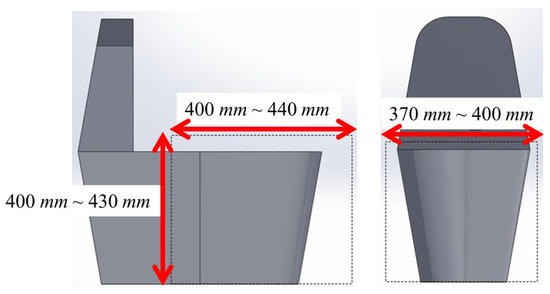 Figure 12. The dimension constraints of the auxiliary standing toilet chair.
Figure 12. The dimension constraints of the auxiliary standing toilet chair. - The standing function can be achieved by using two actuators.
- In this study, the stroke and speed of the actuator are 150 mm and 18 mm/s, and the maximum driving force is 2000 N, as shown in Figure 13. This allows the seat to reach the standing position in approximately 10 s.
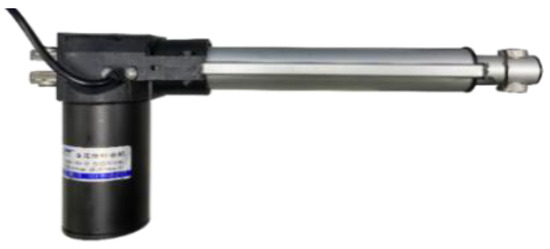 Figure 13. The actuator has a stroke of 150 mm, a speed of 18 mm/s, and a maximum driving force of 2000 N.
Figure 13. The actuator has a stroke of 150 mm, a speed of 18 mm/s, and a maximum driving force of 2000 N.
4.3. Kinematic Design, Kinematic Analysis, and Driving Force Analysis
The existing designs do not satisfy all design requirements. This study proposes improved mechanisms for the auxiliary standing toilet chair. The four design examples illustrate the design process.
4.3.1. Design Concept I
Design Example I
In Design Concept I, Design Example I is proposed for an auxiliary standing toilet chair, as shown in Figure 14. Figure 14a–c show its sitting and standing mechanisms and corresponding dimensions. The analysis using the computer-aided engineering software INSPIRE shows that the seat link (3) achieves a rotation angle of 48°. For a person weighing 150 kg (equivalent to 1500 N), the required actuator force is 2258 N, as shown in Figure 14d. This design has the following characteristics:
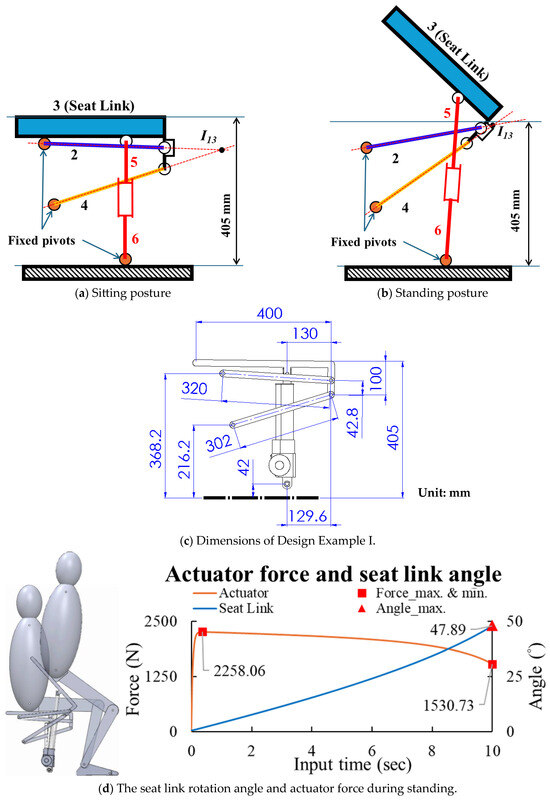
Figure 14.
Design Example I for Design Concept I.
- The seat link rotates 48° during the sit-to-stand transition.
- The height dimensions meet the design requirements of 400 mm to 430 mm.
- The standing function is achieved using 2 actuators with a stroke of 150 mm, a speed of 18 mm/s, and an actuator force of 4000 N (2 × 2000 N).
- For a person weighing 150 kg (1500 N), the maximum required actuator force is 2258 N, less than 4000 N, as shown in Figure 14d. This design meets all specified constraints.
4.3.2. Design Concept II
- (a)
- Design Example II
In Design Concept II, Design Example II is proposed for an auxiliary standing toilet chair, as shown in Figure 15. Figure 15a–c show its sitting and standing mechanisms and corresponding dimensions. Analysis using computer-aided engineering software INSPIRE shows that the seat link (3) achieves a rotation angle of 45°. For a person weighing 150 kg (equivalent to 1500 N), the required actuator force is 2265 N, as shown in Figure 15d. This design has the following characteristics:
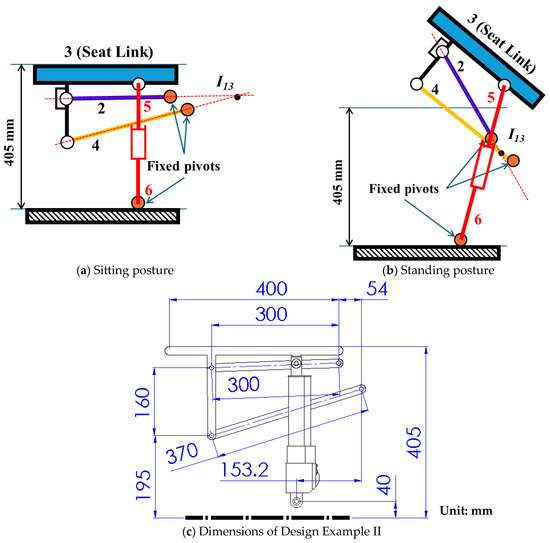
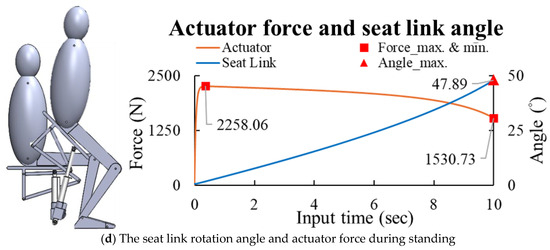
Figure 15.
Design Example II for Design Concept II.
- The seat link rotates 45° during the sit-to-stand transition.
- The height dimensions meet the design requirements of 400 mm to 430 mm.
- The standing function is achieved using 2 actuators with a stroke of 150 mm, a speed of 18 mm/s, and an actuator force of 4000 N (2 × 2000 N).
- For a person weighing 150 kg (1500 N), the maximum required actuator force is 2265 N < 4000 N, as shown in Figure 15d. This design meets all specified constraints.
- (b)
- Design Example III
For Design Concept II, Design Example III is proposed for an auxiliary standing toilet chair, as shown in Figure 16. Figure 16a–c illustrate its sitting, standing, and corresponding mechanism dimensions. Analysis by computer-aided engineering software INSPIRE shows that the seat link (3) achieves a rotation angle of 44°. For a person weighing 150 kg (equivalent to 1500 N), the required actuator force is 2361 N, as shown in Figure 16d. This design has the following characteristics:
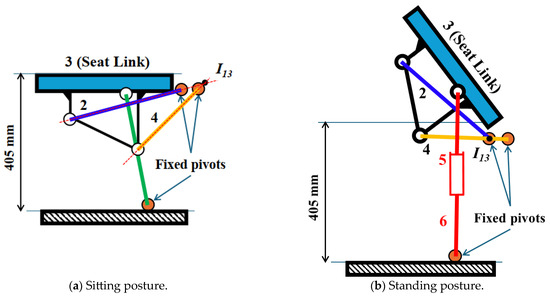
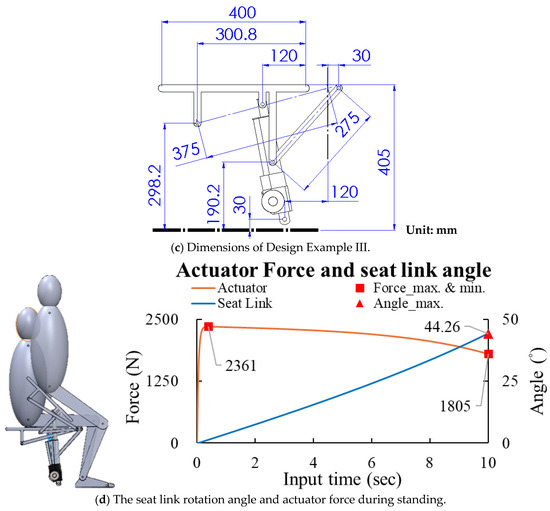
Figure 16.
Design Example III for Design Concept II.
- The seat link rotates approximately 45° during the sit-to-stand transition.
- The height dimensions meet the design requirements of 400 mm to 430 mm.
- The standing function is achieved using 2 actuators with a stroke of 150 mm, a speed of 18 mm/s, and an actuator force of 4000 N (2 × 2000 N).
- For a person weighing 150 kg (1500 N), the maximum required actuator force is 2361 N < 4000 N, shown in Figure 16d. This design meets all specified constraints.
4.3.3. Design Concept III
Design Example IV
In Design Concept III, Design Example IV is proposed for an auxiliary standing toilet chair, as shown in Figure 17. Figure 17a–c show its sitting and standing mechanisms and corresponding dimensions. Analysis using computer-aided engineering software INSPIRE shows that the seat link (3) achieves a rotation angle of 41.5°. For a person weighing 150 kg (equivalent to 1500 N), the required actuator force is 5364 N, as shown in Figure 17d. This design has the following characteristics:
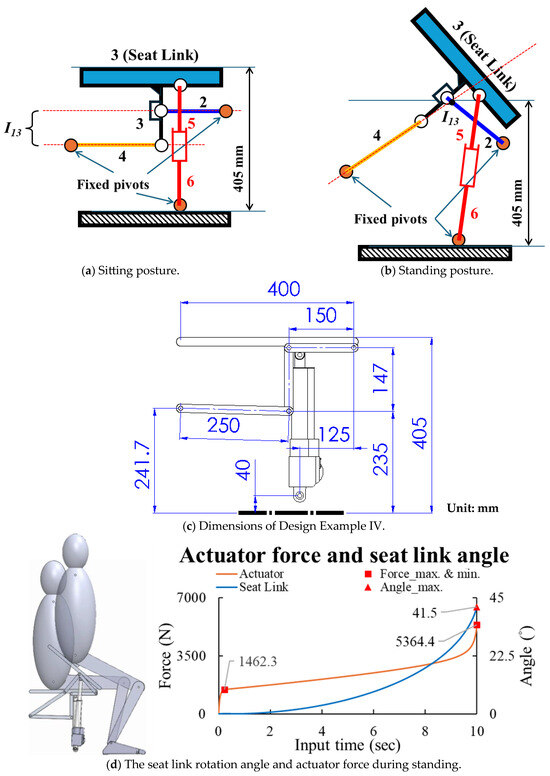
Figure 17.
Design Example IV for Design Concept III.
- The seat link rotates 41.5° during the sit-to-stand transition.
- The height dimensions meet the design requirements of 400 mm to 430 mm.
- The standing function is achieved using two actuators with a stroke of 150 mm, a speed of 18 mm/s, and an actuator force of 4000 N (2 × 2000 N).
- For a person weighing 150 kg (1500 N), the maximum required actuator force is 5364 N > 4000 N, as shown in Figure 17d. This does not satisfy the design constraints.
5. Engineering Design and Prototyping
Based on Design Example I, as shown in Figure 14, engineering drawings for the “auxiliary standing toilet-chair” have been completed. Figure 18 presents the engineering drawings, and Figure 19 shows the prototype.
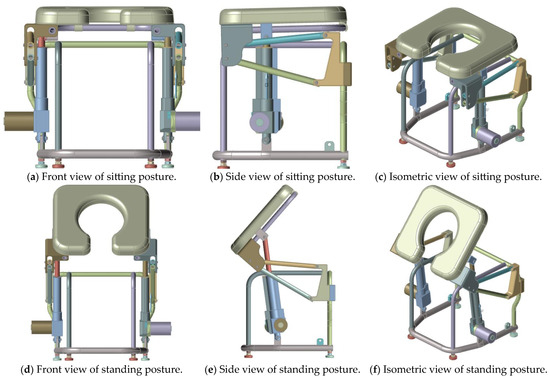
Figure 18.
Engineering drawing of Design Concept I.
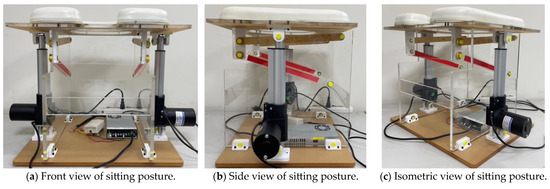
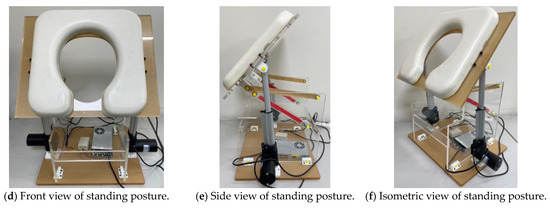
Figure 19.
Prototype of Design Concept I.
6. Conclusions
This study analyzed existing products and patents to develop a more comfortable and ergonomic auxiliary standing toilet chair. The results of this paper are as follows:
- The actuator directly drives the seat link, which rotates around the center of the knee (instant center I13) as much as possible. Its rotation angle reaches 48°, thus eliminating the need for tiptoeing or the downward movement of the hips.
- The toilet chair mechanism is a four-bar linkage that utilizes only revolute pairs, simplifying production and maintenance.
- When assisting a 150 kg person to stand, the maximum required actuator force is only 2258 N, with each actuator bearing 1129 N. This significantly reduced force requirement results in an improved energy efficiency.
Author Contributions
Methodology, L.-C.H. and T.-H.C.; formal analysis, L.-C.H., T.-H.C. and P.-C.L.; software, P.-C.L. and T.-M.H.; data curation, P.-C.L.; writing—original draft preparation, P.-C.L.; writing—review and editing, L.-C.H. and T.-H.C.; project administration, L.-C.H.; funding acquisition, L.-C.H., T.-H.C., P.-C.L. and T.-M.H. All authors have read and agreed to the published version of the manuscript.
Funding
This research was funded by the National Science Council (Taiwan, ROC), grant number NSTC 112-2637-E-150-001.
Data Availability Statement
Data are contained within the article.
Acknowledgments
The authors are grateful to the National Science Council (Taiwan, ROC) for supporting this research under Grant NO. NSTC 112-2637-E-150-001.
Conflicts of Interest
The founders had no role in the design of the study, in the collection, analysis, or interpretation of data, in the writing of the manuscript, or in the decision to publish the results.
References
- Hirschfeld, H.; Thorsteinsdottir, M.; Olsson, E.; Pai, Y.-C.; Wening, J.D.; Runtz, E.F.; Iqbal, K.; Pavol, M.J. Coordinated Ground Forces Exerted by Buttocks and Feet Are Adequately Programmed for Weight Transfer during Sit-to-Stand. J. Neurophysiol. 1999, 82, 3021–3029. [Google Scholar] [CrossRef] [PubMed]
- Sato, S.; Mizuma, M.; Kawate, N.; Kasai, F.; Watanabe, H. Evaluation of Sit-to-Stand Motion Using a Pressure Distribution Measurement System—Effect of Differences in Seat Hardness on Sit-to-Stand Motion. Disabil. Rehabil. Assist. Technol. 2010, 6, 290–298. [Google Scholar] [CrossRef] [PubMed]
- Yu, S.-F. Toilet Aid for the Aged. TW M579023, 11 June 2019. [Google Scholar]
- Huang, K.-Y. Research and Development of a Lifting Mechanism for Toilets. Master’s Thesis, Taipei University of Technology, Taiper, Taiwan, 2011. [Google Scholar]
- Song, S.Y. Apparatus for Lifting Movable Base of Toilet. U.S. Patent 11160424 B2, 2 November 2021. [Google Scholar]
- Houston, J.; Freidenberger, R. Heavy Duty Power-Assisted Toilet Seat Lift Assembly. U.S. Patent 6154896 A, 5 December 2000. [Google Scholar]
- Osborn, A.F. Applied Imagination: Principles and Procedures of Creative Thinking; Scribner: New York, NY, USA, 1957. [Google Scholar]
- Yan, H.-S. Creative Design of Mechanical Devices; Springer Science & Business Media: Berlin/Heidelberg, Germany, 1998. [Google Scholar]
- Hsu, M.; Chen, H.-Y.; Liu, J.-Y.; Chen, C.-L. Dual-Purpose Wheelchair Mechanism Designs. In Proceedings of the International MultiConference of Engineers and Computer Scientists, Hong Kong, China, 5–7 July 2009; Volume 2, pp. 18–20. [Google Scholar]
- Hsieh, L.-C.; Chen, T.-H. The Innovative Design and Prototype Verification of Wheelchair with One Degree of Freedom to Perform Lifting and Standing Functions. In Proceedings of the 3rd International Conference on Mechanical Engineering and Automation Science (ICMEAS 2017), Birmingham, UK, 13–15 October 2017; Volume 280, p. 012027. [Google Scholar] [CrossRef]
- Hsieh, L.-C.; Chen, T.-H. The Systematic Design and Prototype Verification of the Wheelchair with Standing and Tilting Functions. J. Chin. Soc. Mech. Eng. 2020, 41, 49–58. [Google Scholar]
- Yuan, Z.; Gilmartin, M.J.; Douglas, S.S. Optimal Mechanism Design for Path Generation and Motions With Reduced Harmonic Content. J. Mech. Des. 2004, 126, 191–196. [Google Scholar] [CrossRef]
- Hsieh, W.-H. Kinematic Synthesis of Cam-Controlled Planetary Gear Trains. Mech. Mach. Theory 2009, 44, 873–895. [Google Scholar] [CrossRef]
- Li, H.; Zhang, Y. Seven-Bar Mechanical Press with Hybrid-Driven Mechanism for Deep Drawing; Part 1: Kinematics Analysis and Optimum Design. J. Mech. Sci. Technol. 2010, 24, 2153–2160. [Google Scholar] [CrossRef]
- Hsieh, W.-H.; Tsai, C.-H. On a Novel Press System with Six Links for Precision Deep Drawing. Mech. Mach. Theory 2011, 46, 239–252. [Google Scholar] [CrossRef]
- Chen, F.-C.; Tzeng, Y.-F.; Chen, W.-R. On the Mechanism Design of an Innovative Elliptical Exerciser with Quick-Return Effect. Int. J. Eng. Technol. Innov. 2018, 8, 228–239. [Google Scholar]
Disclaimer/Publisher’s Note: The statements, opinions and data contained in all publications are solely those of the individual author(s) and contributor(s) and not of MDPI and/or the editor(s). MDPI and/or the editor(s) disclaim responsibility for any injury to people or property resulting from any ideas, methods, instructions or products referred to in the content. |
© 2025 by the authors. Licensee MDPI, Basel, Switzerland. This article is an open access article distributed under the terms and conditions of the Creative Commons Attribution (CC BY) license (https://creativecommons.org/licenses/by/4.0/).